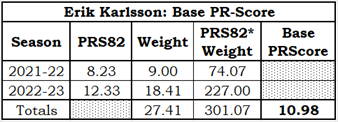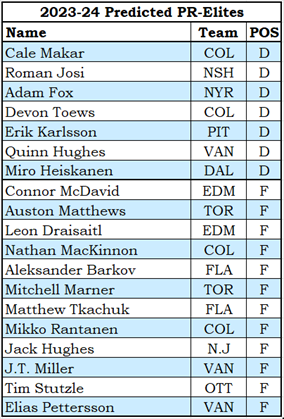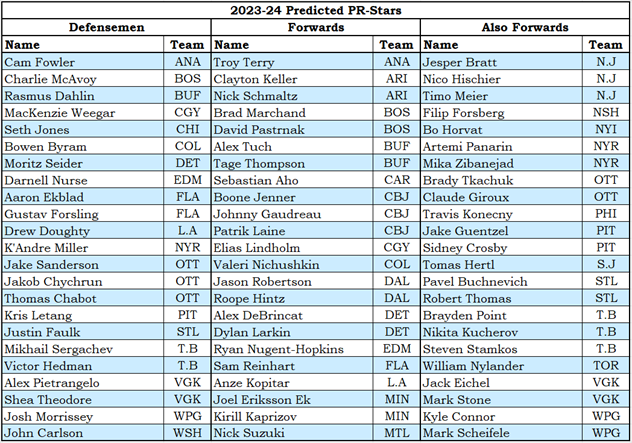I was driving around to do some chores on a Saturday morning in September with the radio station tuned to Team 1200. I was expecting to hear Kevin Haime as it was the time for his weekly golf show, but I immediately recognized the dulcet tones of Dean Brown, the longtime play-by-play broadcaster of the Senators. Haime was interviewing Brown, and they were talking hockey instead of golf (probably because it was late in the interview).
Mr. Brown opined that for the first time in many seasons, Ottawa’s top-four defensemen were those of a playoff-team caliber. That got my mind racing. Going into the 2023-24 season, which team has the best top-four defensemen? Which team has the best top-six forwards? Who will be the top players? Am I really going to waste my time making predictions that will not be as accurate as weather forecasts?
Let me answer that last question first: yes, I am going to waste my time.
Predictions Should Not be Taken Seriously
If you are looking for me to help you organize your picks in a player draft or to help you place bets on teams, I can only say: what are you thinking? Or perhaps that would be better worded as: What? Are you thinking?
Predictions are a staple of pre-game sports broadcasts. Betting professionals will wax philosophical as to who will win a particular game, and why they will win. They’ll give you advice about who to pick in your season-long draft, about who to bench and who to play in your fantasy league, and whether you should take the over or the under (dog-and-under is a favourite wager of mine because I like saying it). In NFL Sunday morning broadcasts, former players and coaches are given the role of betting professionals.
You’ll notice that they don’t agree with each other and that they are right about 50% of the time (unless they are picking which team will win, which is usually better than a 50-50 proposition). If predictions could be made accurately, the predictors would agree with each other much more frequently, they’d win much more often than they lose, and watching the pregame broadcast would not be as interesting.
The reason that sport is so engaging is that the outcomes of contests cannot be predicted with much accuracy. Upsets make sports interesting. It’s why we watch.
So, take my predictions with a three-finger pinch of salt. If they turn out to be reasonably accurate, nobody will be more surprised than me.
How 2023-24 Productivity Rating (PR) Will Be Predicted, Generally
I will only make predictions for players who played at least 20 games last season and at least 41 games in at least one of the last two seasons: 646 players qualified.
Qualified players will get a base PR-Score using their PR-Scores from 2021-22 and 2022-23. Adjustments will be made for games missed and for players who improved in 2022-23. The base PR-Score will then be multiplied by an age-skill-level factor to produce the prediction.
It might not be as complicated as it sounds, but it sure isn’t simple. Let’s look at a specific player who will serve as an example. As I’m an Ottawa Senators fan I wanted to find a favourite player who had a better 2022-23 season than he did in 2021-22. There was an obvious choice: Tim Stutzle Erik Karlsson.
How 2023-24 Productivity Rating (PR) Will Be Predicted, Using an Example
Normally, I prefer my predictions to be on the pessimistic side. For this article, I am going to be very optimistic.
For any season in which a player played at least 20 games, I will calculate their season’s 82-game PR-Score (PRS82). So I can use the PR-Score they “would have had” if they had played a full season.

A player’s Base PR-Score will be nine times his 2021 PRS82 plus ten times his 2022 PRS82, which is then divided by 19. To provide a higher base PR-Score to players who had a better 2022-23 than 2021-22, the weight of their 2022 PRS82 will be increased by half the square of the increase. Karlsson’s 2022 PRS82 is 4.10 higher, so his 2022 weight is 18.41 (an increase of 8.41, which is half the square of 4.10).

This also increases the divisor used to calculate the base PR-Score: it will be 27.41 (9+18.41) instead of 19 (9+10).

The final step in calculating the predicted PR-Score is to adjust the Base PR-Score due to the player’s age and PR-Category. The age-skill factor reflects the idea that a player improves in his youth, declines as he ages, and that better players maintain more of their value from season to season. Erik Karlsson, a 32-year-old with a Base PR-Category of PR-Elite (as his Base PR-Score is greater than 9.9999), has an age-skill factor of 0.96.
Erik Karlsson’s 2023-24 Predicted PR-Score is 10.54 (10.98 * 0.96 = 10.54).
As a side note, the Base PR-Score of a player who played less than 20 games in 2021-22 will be his 2022-23 PRS82. Scott Harrington (D, ANA) played 7 games in 2021-22 and 45 in 2022-23. His 2022-23 PRS82 is 5.28, and his Base PR-Score is 5.28.
Predicted PR-Elites

20 players were in the PR-Elite category in 2022-23; 19 are predicted to be PR-Elite in 2023-24. Players in the table are sorted by position and by predicted PR-Score, with the better players on the top of their positions.
Four players from Colorado made the list: defensemen Makar and Toews, forwards MacKinnon and Rantanen. 21 teams have no projected PR-Elite players, amongst them being Tampa Bay, Vegas, and Boston.
Are there any surprises in these nineteen players? Maybe Jack Hughes (N.J.) could be considered a surprise. He was a PR-Star last season but is young and likely to improve, and is looking forward to a full season of play with Timo Meier. (His potential linemates were not part of the calculations.)
How about surprise exclusions? Moritz Seider (DET) just missed making the list, as did Kirill Kaprizov (MIN) and Jason Robertson (DAL).
Predicted PR-Stars

A couple of forwards were left off the list so that the table would have three columns and 23 rows. I’m all about symmetry.
It’s hard to nicely present the names of 69 players. In order to make it easier to find the players that may be of interest to you, they are organized by position (first-column defensemen), then by team and player name.
Ottawa and Tampa Bay have five projected PR-Stars (three defensemen and two forwards for Ottawa, two and three for Tampa Bay). Vancouver had three players projected as PR-Elites but had no players projected as PR-Stars.
Seattle has no players projected to be PR-Elite or PR-Star. They are truly a team of second and third liners.
Summary
The optimistic approach produced a few more PR-Stars than there will be. The table showed 69 players, and a few were left off for symmetry purposes. It would be surprising for there to be more than 60 PR-Stars next season (or in any season). As mentioned earlier, the reason why PR-Star players would not end up with PR-Star seasons is injury. Many of these players will miss enough games that they’ll fall short of the PR-Star category, but it is almost impossible to predict which of the 69 will fall short.
Considering that predicting the future performance of NHL players is completely unreliable, I’m satisfied with the results.
In a future article, I will use these PR-Predictions to identify which teams will make the playoffs in 2023-24.
Related Articles
Introduction to Productivity Rating
